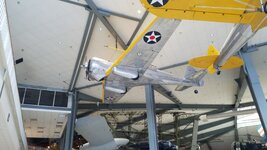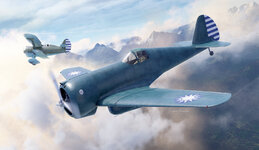Wild_Bill_Kelso
Senior Master Sergeant
- 3,231
- Mar 18, 2022
Reading about the Boomerang and the Wirraway, it's clear that the nascent Australian aircraft industry had some capability, and they were eager to produce some aircraft with which to contribute to the war effort and to their own regional defense, instead of just waiting for aircraft to arrive from England or the US.
The problem with the Boomerang of course is that it was based on a trainer, so no matter how much they improved the design around the margins, they still had an aircraft that wasn't going to be able to tangle with Japanese fighters, or for that matter chase down and intercept most Japanese bombers.
So what if we pick another airframe and equip it with an Aussie made R-1830 engine. Which would would be in the sweet spot of easy to adapt, relatively easy to produce, capable enough as a fighter, and have the potential to be improved into a better fighter.
Some possible candidates:
Brewster B.239 / Buffalo
Bristol Beaufighter*
Fiat G.50**
Fokker D.XXI
Gloster F-5/34
Gloster F9
P-36 / Hawk 75
Re 2000**
Seversky P-35
* I think (?) they did eventually make some of these but what if they got the ball rolling on this earlier? The Beauforts were certainly worth producing.
** Assuming they could have gotten the License from Italy before the war started
Maybe a little far-fetched (conversions from in-line) but still maybe worth considering
Avia B.35
Westland Whirlwind
Hawker Henley
Dewoitine D.520
Any of these seem like they could have been feasible? It seems like a slightly improved Gloster F-5, Fokker D.XXI or P-36 could have been within the capabilities of CAC and may have been somewhat useful for Australia's emergency needs and some of the other regional allies.
The problem with the Boomerang of course is that it was based on a trainer, so no matter how much they improved the design around the margins, they still had an aircraft that wasn't going to be able to tangle with Japanese fighters, or for that matter chase down and intercept most Japanese bombers.
So what if we pick another airframe and equip it with an Aussie made R-1830 engine. Which would would be in the sweet spot of easy to adapt, relatively easy to produce, capable enough as a fighter, and have the potential to be improved into a better fighter.
Some possible candidates:
Brewster B.239 / Buffalo
Bristol Beaufighter*
Fiat G.50**
Fokker D.XXI
Gloster F-5/34
Gloster F9
P-36 / Hawk 75
Re 2000**
Seversky P-35
* I think (?) they did eventually make some of these but what if they got the ball rolling on this earlier? The Beauforts were certainly worth producing.
** Assuming they could have gotten the License from Italy before the war started
Maybe a little far-fetched (conversions from in-line) but still maybe worth considering
Avia B.35
Westland Whirlwind
Hawker Henley
Dewoitine D.520
Any of these seem like they could have been feasible? It seems like a slightly improved Gloster F-5, Fokker D.XXI or P-36 could have been within the capabilities of CAC and may have been somewhat useful for Australia's emergency needs and some of the other regional allies.



